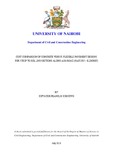| dc.description.abstract | The thesis seeks to find out the better option between concrete and flexible pavement in cost savings and service provision over a design period of time for the steep to rolling sections of road AI04 (Nakuru - Eldoret) at Timboroa. On the flat terrain section of the road, minimal or no failure is experienced, however on the steep and rolling sections, failure is evident through rutting, caking, cracking amongst others. Flexible pavement is currently the pavement used in the section. The problem therefore, that the thesis is focusing on is the considerable failure on the steep to rolling sections while on immediate flat sections, minimal or no failure is experienced. The failure is evident on both the ageing section and the freshly reconstructed section.
The thesis covers the design of both a concrete and flexible pavement and computation of respective costs over a study period of forty years for the section, to inform whether it will be cheaper to introduce concrete pavement on the steep to rolling section or retain the flexible pavement. The study appreciates that concrete pavement has not established roots in Kenyan roads and th;refore an attempt to assess if it can be a better solution on the failed sections. The objectives of the study are to establish the axle loading from the vehicles and strength of insitu materials to be used for the design of the two pavements and computation of respective costs for comparison.
The methodology included the use of descriptive statistics which included tally sheets which were used for collection of data while inferential statistics was used for analysis and presentation of the results and included amongst others graphs and charts. Both primary and secondary data were collected; secondary data was obtained from journals, books and reports by various organizations. Primary data was obtained from traffic count, material sample picking and testing and site tests. The material and traffic data was used to come up with the pavement design details which included respective pavement layers, materials used and ultimately used for computation of unit costs for each pavement which was used for cost companson.
From the data collected and analyzed, the road was established to be a high traffic volume and
heavily loaded road. It was also established that the insitu materials were not strong enough and therefore needed to be improved or strengthened. From the cost analysis, flexible pavement was cheaper in initial construction by about 79%, however, over the analysis period, a concrete pavement was 57.45% cheaper than a flexible pavement. It is therefore recommended that in the steep to rolling sections of the road, it would be preferably cheaper to use concrete pavement. | en |

